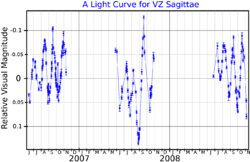Astronomy:13 Sagittae
| Observation data Equinox J2000.0]] (ICRS) | |
|---|---|
| Constellation | Sagitta |
| Right ascension | 20h 00m 03.30846s[2] |
| Declination | +17° 30′ 59.4373″[2] |
| Apparent magnitude (V) | 5.33[1] |
| Characteristics | |
| Spectral type | M4 III[1] |
| B−V color index | 1.576±0.010[3] |
| Variable type | semiregular[4] |
| Astrometry | |
| Radial velocity (Rv) | −17.56±0.33[5] km/s |
| Proper motion (μ) | RA: +1.75[2] mas/yr Dec.: −12.41[2] mas/yr |
| Parallax (π) | 3.20 ± 0.31[2] mas |
| Distance | 1,020 ± 100 ly (310 ± 30 pc) |
| Absolute magnitude (MV) | −2.12[3] |
| Details | |
| Radius | 185.7[6] R☉ |
| Luminosity | 2173.57[3] L☉ |
| Surface gravity (log g) | 3.00[7] cgs |
| Temperature | 3,844±251[8] K |
| Other designations | |
| Database references | |
| SIMBAD | data |
13 Sagittae is a single[10] star in the northern constellation of Sagitta. The designation comes from the star catalogue of John Flamsteed, first published in 1712. It can be viewed with the naked eye, having an apparent visual magnitude of 5.33.[1] Based upon an annual parallax shift of 3.20 mas as seen from Earth's orbit, it is located at a distance of around 310 parsecs (1,000 ly). It is moving closer to the Sun with a heliocentric radial velocity of −17.56 km/s.[5]
| Period (days) |
Amplitude (magnitude) |
|---|---|
| 36.5 | 0.082 |
| 39.2 | 0.043 |
| 51.4 | 0.031 |
| 65.2 | 0.030 |
This is an evolved red giant with a stellar classification of M4 III[1] – a star that has used up its core hydrogen and has expanded – and is currently on the asymptotic giant branch.[7] Classified as a semiregular variable and given the variable star designation VZ Sagittae, it varies between apparent magnitudes 5.27 and 5.57.[4] Il has expanded to around 186 times the Sun's radius.[6]
There is a magnitude 9.96 companion located at an angular separation of 112.6 arcseconds along a position angle of 297°, as of 2013.[11] Designated HD 351107, this is a class F0 star.[12]
References
- ↑ 1.0 1.1 1.2 1.3 1.4 1.5 Tabur, V. et al. (December 2009). "Long-term photometry and periods for 261 nearby pulsating M giants". Monthly Notices of the Royal Astronomical Society 400 (4): 1945–1961. doi:10.1111/j.1365-2966.2009.15588.x. Bibcode: 2009MNRAS.400.1945T.
- ↑ 2.0 2.1 2.2 2.3 2.4 van Leeuwen, F. (2007). "Validation of the new Hipparcos reduction". Astronomy and Astrophysics 474 (2): 653–664. doi:10.1051/0004-6361:20078357. Bibcode: 2007A&A...474..653V.
- ↑ 3.0 3.1 3.2 Anderson, E.; Francis, Ch. (2012), "XHIP: An extended hipparcos compilation", Astronomy Letters 38 (5): 331, doi:10.1134/S1063773712050015, Bibcode: 2012AstL...38..331A.
- ↑ 4.0 4.1 VSX (25 August 2009). "VZ Sagittae". AAVSO Website. American Association of Variable Star Observers. http://www.aavso.org/vsx/index.php?view=detail.top&oid=27385. Retrieved 4 January 2015.
- ↑ 5.0 5.1 Famaey, B. et al. (January 2005). "Local kinematics of K and M giants from CORAVEL/Hipparcos/Tycho-2 data. Revisiting the concept of superclusters". Astronomy and Astrophysics 430: 165–186. doi:10.1051/0004-6361:20041272. Bibcode: 2005A&A...430..165F.
- ↑ 6.0 6.1 Vallenari, A. et al. (2022). "Gaia Data Release 3. Summary of the content and survey properties". Astronomy & Astrophysics. doi:10.1051/0004-6361/202243940 Gaia DR3 record for this source at VizieR.
- ↑ 7.0 7.1 Ortiz, Roberto; Guerrero, Martín A. (2016). "Ultraviolet emission from main-sequence companions of AGB stars". Monthly Notices of the Royal Astronomical Society 461 (3): 3036. doi:10.1093/mnras/stw1547. Bibcode: 2016MNRAS.461.3036O.
- ↑ Soubiran, C. et al. (June 2010), "The PASTEL catalogue of stellar parameters", Astronomy and Astrophysics 515: A111, doi:10.1051/0004-6361/201014247, Bibcode: 2010A&A...515A.111S
- ↑ "13 Sge". SIMBAD. Centre de données astronomiques de Strasbourg. http://simbad.u-strasbg.fr/simbad/sim-basic?Ident=13+Sge.
- ↑ Eggleton, P. P.; Tokovinin, A. A. (September 2008). "A catalogue of multiplicity among bright stellar systems". Monthly Notices of the Royal Astronomical Society 389 (2): 869–879. doi:10.1111/j.1365-2966.2008.13596.x. Bibcode: 2008MNRAS.389..869E.
- ↑ Mason, B. D. et al. (2014), "The Washington Visual Double Star Catalog", The Astronomical Journal 122 (6): 3466, doi:10.1086/323920, Bibcode: 2001AJ....122.3466M
- ↑ Nesterov, V. V. et al. (1995). "The Henry Draper Extension Charts: A catalogue of accurate positions, proper motions, magnitudes and spectral types of 86933 stars". Astronomy and Astrophysics 110: 367. Bibcode: 1995A&AS..110..367N.
 |


